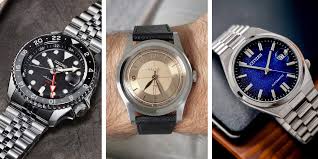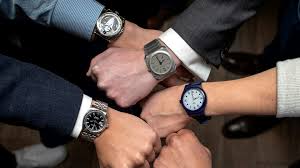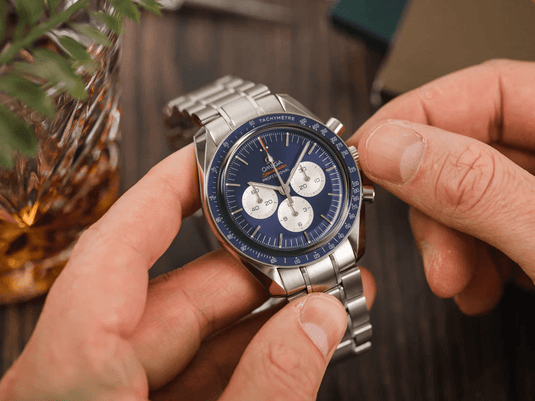In a world dominated by smartwatches and quartz-powered timepieces, there’s something undeniably fascinating about the intricate, self-sustaining mechanism of an automatic watch. Known for their craftsmanship, heritage, and mechanical brilliance, automatic watches don’t require batteries—yet they keep ticking for decades, often passed down through generations.
If you've ever wondered how an automatic watch works, you're in the right place. This article will break it all down—from the mechanics inside to how motion powers the watch, and why these devices remain beloved by collectors and horology enthusiasts alike.
What Is an Automatic Watch?
An automatic watch—also known as a self-winding watch—is a mechanical timepiece powered by the natural movement of the wearer's wrist. Unlike quartz watches that run on batteries, automatic watches operate through a complex system of gears, springs, and rotors.
As you go about your day—walking, typing, or even moving your hand—the movement of your wrist causes a rotor inside the watch to spin. This energy is then stored in a mainspring, which powers the watch and keeps it ticking.
A Brief History of Automatic Watches

The concept of automatic winding dates back to the 18th century. In 1776, Swiss watchmaker Abraham-Louis Perrelet developed the first self-winding mechanism for pocket watches. However, it wasn’t until the 1920s and 1930s that automatic wristwatches became commercially viable.
Rolex played a significant role in popularizing the technology with the launch of the Oyster Perpetual in 1931. Since then, automatic watches have become synonymous with quality, craftsmanship, and status.
The Basic Components of an Automatic Watch
To understand how automatic watches work, let’s break down the essential components inside their cases:
1. Rotor
-
A semi-circular metal weight that spins with the movement of your wrist.
-
Mounted on a pivot, allowing it to rotate 360° freely.
-
The rotor’s motion winds the mainspring automatically.
2. Mainspring
-
A tightly coiled spring that stores mechanical energy.
-
As the rotor turns, it winds the mainspring.
-
The energy is slowly released to power the movement.
3. Gear Train
-
Transfers energy from the mainspring to the escapement.
-
Consists of a series of interconnected gears that reduce and manage energy flow.
4. Escapement
-
Acts like a gatekeeper, regulating the release of energy from the mainspring.
-
Transfers consistent energy pulses to the balance wheel.
5. Balance Wheel
-
Oscillates back and forth at a consistent rate (usually 28,800 beats per hour in modern watches).
-
Maintains precise timekeeping by dividing time into equal segments.
6. Dial Train and Hands
-
The dial train moves the hour, minute, and second hands using the energy transmitted through the gear train.
How the Automatic Movement Works (Step-by-Step)

Here’s how everything comes together inside an automatic watch:
Step 1: Motion of the Wrist
Your natural wrist movement causes the rotor to pivot and spin. Because the rotor is unbalanced (heavier on one side), it responds to even small motions.
Step 2: Rotor Winds the Mainspring
The spinning rotor is connected to a series of gears that wind the mainspring. As the rotor moves, it automatically tightens the mainspring, storing potential energy.
Step 3: Mainspring Releases Energy
Once wound, the mainspring slowly unwinds. This stored energy flows through the gear train, powering the rest of the movement.
Step 4: Escapement Regulates Energy
The escapement releases the energy in precise, controlled bursts, ensuring that the gear train moves at a consistent speed.
Step 5: Balance Wheel Keeps Time
The escapement’s impulses keep the balance wheel oscillating. These oscillations regulate the timekeeping, ensuring the hands move accurately.
Step 6: Hands Move
The consistent rotation of the gear train turns the hour, minute, and second hands at the correct rate, allowing you to tell time.
Power Reserve: How Long Will It Run?
Most automatic watches have a power reserve—the amount of time a watch will keep running without motion—of 38 to 50 hours. Some high-end models offer up to 70 hours or more.
If an automatic watch is left unworn for a couple of days, it may stop. When that happens, you’ll need to manually wind it or give it a few shakes to restart the rotor.
Can You Overwind an Automatic Watch?

Most automatic watches are designed with a slipping clutch mechanism. This means the mainspring will disengage from winding once it’s fully tight, preventing damage from overwinding. So, while it’s generally safe to manually wind an automatic watch, there's no need to keep winding once it’s fully charged.
Manual Winding vs. Automatic Winding
Automatic watches can often be manually wound using the crown, especially if they haven’t been worn for a while. Here’s how they compare:
| Feature | Manual Winding | Automatic Winding |
|---|---|---|
| Power Source | Hand-wound via crown | Wrist motion and/or crown winding |
| Frequency | Typically once per day | As long as worn regularly |
| Risk of Overwinding | Yes (stop when resistance is felt) | No (slipping clutch system) |
| Maintenance | Similar – regular servicing needed | Similar – regular servicing needed |
Pros and Cons of Automatic Watches
✅ Pros
-
No battery required
-
Environmentally friendly
-
Intricate craftsmanship and visual appeal (especially with open case backs)
-
Lasts for decades with proper care
-
Builds emotional and collectible value
❌ Cons
-
Less accurate than quartz watches
-
Requires regular wear or winding
-
More expensive than battery-powered watches
-
Sensitive to shocks and magnetic fields
How to Keep an Automatic Watch Running
Here are some tips to ensure your automatic watch functions reliably:
1. Wear It Regularly
Most automatic watches are designed to stay wound if worn for at least 8–10 hours per day.
2. Manually Wind If Needed
If your watch hasn’t been worn for a while, wind it about 30–40 turns using the crown.
3. Use a Watch Winder
A watch winder mimics the motion of the wrist, keeping your watch running even when not worn. Great for collectors with multiple watches.
4. Service Regularly
Every 3–5 years, take your watch to a professional for cleaning, lubrication, and calibration.
5. Avoid Extreme Conditions
Keep your watch away from magnets, strong vibrations, and extreme temperatures, all of which can affect accuracy.
Are Automatic Watches Worth It?
If you appreciate fine craftsmanship, mechanical innovation, and timeless design, then yes—automatic watches are worth the investment. They offer a deeper connection than digital or quartz alternatives. For many owners, an automatic watch isn’t just a tool—it’s a legacy.
From entry-level brands like Seiko and Tissot to luxury names like Omega and Rolex, there’s an automatic watch for every taste and budget.
Final Thoughts
Automatic watches are marvels of engineering. With no need for batteries and a reliance on pure motion and mechanics, they represent the heart of traditional watchmaking. Whether you're a first-time buyer or a seasoned collector, understanding how automatic watches work adds a new layer of appreciation to your timepiece.
So, the next time you glance at your wrist, remember: every tick of an automatic watch is powered by your own movement—and centuries of innovation.


